|
Juanita Canzoneri Commonwheel Artists Co-op curator for Fiber = Art When I proposed the concept for this show to Liz Kettle and Susan Haldeman at Textiles West I was thrilled that they were as excited about the idea as I was. Liz’s “stitch meditation” series was part of the inspire for this event. I’ve been working in fiber since childhood. I was raised by a mother who knits and sews and that modeled for me the beauty and utilitarianism of the art form. I worked in the theater costume shop in college and set up my own sewing room once out of college, designing my own wardrobe. I started working in glass mosaics in 2001 and put fiber to the side. But in the past decade the non-functional uses for fiber work have become more important to me than making things to be worn on the body. I started with working in alternative fibers, such as video tape and audio cassette tape. Since they were too stiff to be comfortably worn I started yarn bombing with them and created a few larger installation pieces—the first of which is still on my gate. My pieces for this show incorporate collaged Styrofoam and ping pong balls and covered them in decorative crochet. I’ve taken groupings of these and assembled them into mobiles—a new art form for me! I hope you enjoy seeing the work we’ve assembled for this show as much as we have enjoyed putting it together. The range of talents and fiber art styles we’ve drawn is astounding. Heather Cotterman I have always been in love with fiber and color, in all forms. Throughout my artistic career I have experimented with fiber in many forms. My journey began in the quilting world making a blanket for my oldest child before she was born, 17 years ago. I soon began to play with fabric and thread like they were paints. Once we moved to Colorado I explored patterned pen and ink drawing and started on my journey of converting my drawings into fiber art pieces. Once in Colorado I had time to pursue my fiber arts business through raising a fiber flock that includes angora goats, angora rabbit, and sheep. In addition to my art quilts I spend time hand-dying my hand-spun art yarn, weaving, and making silk sculptures. My pieces often come from images from my dreams. I have yet to be able to fully capture what I see in my dreams, which provides many opportunities to capture my imagination. Both "Bridge of Dreams" and "Daphne" are sketches that came about, in the middle the night, after waking from a dream. Very rarely do I have an intent when I begin to sketch. It’s almost like my subconscious is drawing. As I am working and sometimes not till I’m finished, meaning begins to take form. My hope is that working in this manner gives my work a sense of organic mysticism and spirituality that can speak to many on an individual sense. “Daphne” is a perfect example of the evolutionary qualities of my artistic process. Rhonda Denney I have always been interested in art. During high school and college I attended art classes, but my degree and business career was in something totally different. I used art as a way to relax, but my career took me away from it. It was my husband who encouraged me to get back to it. I started in fiber art around 2004 or so. Essentially, I started creating my art using fabrics and stitching. Then I discovered that using pigments opened my creative potential to a new dimension. Every time I create a piece I experiment more and learn more. I call my technique “Pigment Patchwork”. I love the challenge of capturing the spirit of my subjects in my artwork. As I work on a project each piece seems to take on a life of its own, developing through the entire process. I love watching people look at my work, seeing them examine the piece to try to determine what exactly it is; a photograph, a painting? Then, when they realize that it consists of fabric with stitching it requires a closer look and the need for a tactile confirmation becomes stronger. I love experimenting with pigments on fabric. In this series, called “The Eyes Have It”, my work zooms in to get a closer look at my subjects, including their eyes. For this piece I wanted the texture to come through as well. This piece was created using my Pigment Patchwork technique. Once I decided on my subject matter, using photographs as inspiration, I sketched the chameleon onto a large piece of silk noil fabric. Using water-soluble pigments I created the texture of his skin. Once completed, I chose the background fabric and mounted him onto it. Using a sewing machine, I added stitching for dimension on my sandwiched structure, using mono-filament threads so the colors would show through. The finished product was then mounted onto a wood panel. I love catching people’s attention with the detail and reality of my pieces. I want them to come closer to see the detail. My artist web site is: www.RhondaDenney.com. I also have items including limited edition prints and notecards of my work at my home studio and the following Galleries: Strictly Guffey, Guffey, CO 3rd Street Gallery, Westcliffe, CO M. Lynette Holmes My fascination with and love of fabric began in my childhood. It was very exciting to choose fabric for my school clothes from the catalogs. I remember the smell of the paint as my mother stenciled on tablecloths. Occasionally, I would get a peek at the Japanese doll wrapped in tissue taken out of a special drawer and wonder about the mystique surrounding it. This was the beginning of my interest in making cloth, dyeing cloth, Asian art and working as a fiber artist. I have been weaving and dyeing cloth for many years and presently concentrating on art quilts using surface design. Art for me is problem solving, challenging, and at the same time joyful! In this show, all of my works use collage, layering of fabrics, and to different degrees, hand-stitching. The stitching process helped me focus during a time of transition when time and access to materials and my sewing machine were scarce. In “Under the Sun” a forest is hand-stitched onto three layers of silk cloth. The hand stitching in the three smallest pieces manipulates the cloth creating texture and movement. The colors contribute to a universal theme of flowing water and is calming. My favorite piece is “Voyage” because I like the variety of processes I used. It is dynamic with strong color and movement. I like the spiraling and color transition from dark to light. It expresses my thought that each person is on her/his own adventure in life whether purposeful or unknown. The process for Voyage : I began by machine-stitching fabrics arranged by color onto a base fabric. I started with an abstract design and did hand stitching to define some forms. Fabric paint was brushed on in areas where fabric shapes were too sharp. Large sheer fabrics were fused to create movement. Smaller forms were painted with paint sticks onto sheers, then fused and machine sewn. In this instance, the original abstract design disappeared and another vision took its place. From this point on, I viewed it as a whole piece and determined what needed to be added or changed. I painted a large circular line which completes the spiraling. Then, I tweaked it by adding shapes, fabrics, stamping and painting. I machine stitched the whole cloth and added a binding to finish. Contact me at [email protected] Home phone 710-696-8336 Cell phone 904-557-1187 Page Jones I'm originally from Texas. Both of my grandmothers had a love for the fiber arts (though they were geared more towards clothing and stuffed animals), so I became interested, too. I was drawn towards simple embroidery because it was easy to reproduce my pencil sketches in thread. I have been sewing since I was about 8 years old. I was never terribly proficient at it, but I always found joy in stitching on cloth. I started seriously doing embroidery on canvas in 2012. I had just graduated college, and I needed a creative outlet while transitioning from a student to the real world. Ever since, I have been honing my craft. My primary medium is fabric and stitching on canvas, though I dabble in nupastel on canvas as well. I focus on mostly natural and scientific themes. Making art for me is creating a moment of time away from the regular rhythm of life. MY aim is to make a piece that will draw the viewer into a brief period of time where they can just follow the lines and feel the tone of the piece instead of the regular buzz of everything around them. I am primarily a fiber artist, so entering the show was an opportunity to further demonstrate to the community an often overlooked medium. There aren't many fiber art shows out there that focus on non-functional fiber art, and it’s an honor to be a part of one. I derive my inspiration from science and nature, and crinoids is an example of both. I was in the Houston Museum of Natural Science when I saw this massive, beautiful Crinoid fossil on the wall. I felt an instant desire to capture it in embroidery. When I was able to afford the largest canvas I could fit in my car, I got to work. I started with a base layer of natural earth paints to capture the feeling of the rock. I then chose a glittering gold thread so the piece would pop. The embroidery took me around a month and a half, finding time between work and other obligations. I sewed the whole thing free hand, staring at the picture of the fossil, then trying to imitate the ancient creature on canvas. When I was finished, the piece was massive and I was full of pin pricks from my needle, but well worth it. I want the viewer to see the subject as intimately as I did. Whether it is the feeling of seeing a magpie for the first time, or the awe of seeing a towering fossil, I want to convey that same fascinations and wonder. My favorite piece is “Crinoids”. When you spend so much time on one piece, you have many memories associated with its creation. I have many good memories stored in that piece. I have some smaller embroidered pieces in Piazza Navona, 12 Ruxton Ave, Manitou Springs, CO 80829 I created a series of nebulae for sale at KJS Comics in the Citadel Mall, 750 Citadel Dr E #1116, Colorado Springs, CO 80909 I have a few pieces available in a stairway gallery at Curves, 108 W Midland Ave, Woodland Park, CO 80863 I'm on Facebook: https://www.facebook.com/stitchedartbypagejones/ I have a website: https://page-jones.squarespace.com/ I'm open to commissioned pieces, so contact me through my website or Facebook page listed above if you are interested. Stephanie Lyon My interest in Fiber art and craft began as a child. My grandmother was a Hungarian immigrant working as a garment maker in a textile factory in NYC. The beauty and precision of her work fascinated me even as a child. In my teens and twenties I sewed clothing and home goods more as a practical matter than artistic pursuit. And tried my hand at other fiber arts of the time such as macramé. I pursued a career as a computer software engineer so no surprise I found the order and logic of weaving especially interesting. In the early 1990s a workshop with Lore Kadden Lindenfeld (an early female industrial textile designer) confirmed weaving as my true fiber connection. I work almost exclusively on multi-harness floor or table looms. My favorite projects have been weaving with non-traditional materials, creation of dimensional pieces, and garments. My current obsession is woven shibori also known as crimp cloth. It is a fun and fascinating process that produces a fabric with dimension that goes further than texture. I am not sure where it will take me. “A weaver maps out the universe, travels back in time and journeys into the future...”, Gabriel George in A Salish Weaver Making art is my opportunity to turn off the analysis and connect to the creative part of my brain. Seeing the joy it can bring to others is the icing on the cake. While a majority of my weaving is functional, “Pig in the Orchard” is my second pictorial weaving. I chose boundweave structure because it has a rather folk arty look with repeating design motifs. And this structure is done using a regular floor or table loom. I created the first wall hanging as a birthday gift for my husband who had become quite interested in the revival of the American hard cider industry. While the gift was very well received, some important orchard details were declared missing. In particular, a pig. I decided to do this second piece and incorporate some techniques that are not standard for boundweave. In the future, I expect there might be an orchard at night weaving. Designing motifs for boundweave is very much a colored pencil on graph paper process. Each motif is designed around the target number of threads per inch and whether the motif should rise from the sides to the center or fall from the sides to the center. The photo included shows how some trees have upswing on the branches and others have downswing. Each row of boundweave requires multiple passes of the shuttles—in this piece 6—to insert the color that corresponds to each shaft for that row. Going back to the graph paper, each square represents color being woven at a particular row and thread (column). Once the design is completed on paper, the weaving begins from the bottom of the piece to the top. The design is used as a reference and changes are made on the fly as needed. Pictorial boundweave is slow progress but gives the weaver control over the placement of the design motifs while making efficient use of the multi shaft loom. Getting the pig into the picture required some nonstandard manipulations to break the repeating motif of trees and insert a single pig. (The pigs get to eat any fallen fruit while keeping the soil in good condition.) Balancing the scale of the pig with the trees and getting sufficient detail was a bit of a challenge. Luckily, folk art allows one to relax the rules to achieve the proper whimsical result. In general, I love to create weavings that perplex the viewer due to their perceived complexity … which is not necessarily their actual complexity. While I am in the process of setting up an online selling venue at Etsy, it is not complete yet. I am on Instagram at @xweaverwarped. Mary Madison I’ve always been interested in making art, reading and writing. I was fortunate that my family though dirt poor, encouraged me at every turn. When we planted our vegetable garden, I was allowed to grow gladiolas. My dad painted a bedroom wall pink so I could draw flowers on it. My grandmother bought me a set of encyclopedias from a traveling salesman paying pennies weekly. One aunt taught me crocheting while another set up a space just for me to use her sewing machine and my granddad taught me fine stitching by repairing his work clothes. He was a coal miner. His work clothes were torn and well work overalls. So making art isn’t so much what I do, it’s really a large part of who I am. Though much of my energy has been focused on weaving, I also spend a lot of time quilting and eco dyeing. I encountered references about indigo while researching a book I was writing at the time about slave weavers and how they carded fiber, spun, dyed and wove a wide range of household items for plantation owners. I did not know before this that indigo still grows wild in some parts of the south. I am very protective of two indigo plants I’ve been nurturing along, whispering to them that snow isn’t really that bad! The two pieces in the show are a reflection of two dyeing approaches. Though very different, the fiber reactive piece and the indigo dyed piece both speak to my trying to capture a sense of time and how I think of movement between dimensions as timeless and endless. The Evolution depiction, while moving up from water’s depth towards the surface, is still earth-bound. The Portal depiction feels less tied to earths grasp. When people view these pieces I would like for them to acknowledge, as I try to, things past without clinging or lamenting, and be hopeful and unafraid for things to come. My latest efforts have been tied to gardening and figuring out how and where I’m going to plant a hemp crop (the fiber bast species, not the marijuana one) to make yarn using a blending of my alpaca fleece. I’ve recently decided to be more proactive in sharing my work and have a website: MaryMadisonDesigns.com, where I’ve posted pictures of my work and other photographs. I also have a WordPress blog, though seriously not current, where you can read about my writing experience. It is titled Plantation Slave Weavers Remember. Andrea Schumacher I have been doing art since I was a teen. I majored in art at University of Wisconsin, Madison, where I started doing printmaking, painting, and drawing. I moved to Chicago in 1986 to attend the School of the Art Institute of Chicago. I enrolled in a post-baccalaureate program, a one-year program that gave me the equivalent of a B.F.A degree. After a few more years I decided to pursue my MFA in printmaking at SAIC. I remained in Chicago until 2016. I showed in and around Chicago and had a variety of jobs. In 2004 I started working at Columbia College Chicago. I started in a tech position for the Art and Design Department. After a year I started managing the printmaking facility. I also taught a variety of printmaking courses at Columbia. So I have been a practicing artist and art educator for quite a while. Art is an opening into another world, like a book. When I view art I get a chance to experience another point of view, to decode whatever visual system the artist might employ to communicate a message. Art is also like a time capsule to a particular time, society, and location. Making art is a chance to communicate my perspective, my history, my background and experience. My interests are quite varied, and my work reflects that. My work is quite diaristic, it is a record of my interests, obsessions, and problems. My best pieces are ones that communicate something personal but that also transcends my life and connects to larger issues. I have been working with fabric for a few years (since 2015-2016). My sister was an avid quilter and she inspired me to make a few quilts. I made a t-shirt quilt and that led to me to consider using textiles in a more artistic and less functional way. I use recycled functional textiles and some new fabrics. I find that textiles have a lot of potential meaning and history. At times I am simply inspired by the color and tactile nature of material. It became quite evident to me that fabric was a great medium to make works about gender roles and my own personal history as a woman. My sources of inspiration are quite varied. I am drawn to the fashion of the 60’s quite a bit. I am often inspired by theatrical wardrobe because I feel that these pieces of clothing help to convey elements of the character’s emotion and history. Much of my work uses items like buttons, buckles, zippers that convey a sense of containment. There are so many aspects of a garment that function to contain and constrain a body and that is a metaphor for female constraints. The inspiration for “100 Sad Stories” was my Mother. She is very caught up in regret and anger for her life with my Father and her own upbringing. I feel her most significant legacy to me is sadness and regret. So I set out to create an item that could be considered a family heirloom, such as a quilt. This quilt however, would represent poverty and sadness. I wanted to make the most meager and threadbare blanket I could think of. I used a worn piece of wool with visible holes that was about the size of a person. I used a thin but delicate piece as the quilt top and quilted them together using spare buttons. There was no plan or attempt at measuring the quilting, so it is quite off kilter. The finished result was too pretty so I sewed a latticework of lines to connect the buttons and cut out the remaining fabric of the quilt top. The sewn lines look somewhat scar-like and the piece became quite spare but also overworked at the same time. I was not sure about how to display the finished piece and I decided to create an oversized hanger to hang the work. Fabric and home furnishings represent comfort and security of the ideal home. A blanket can be luxurious and comforting. A hand-made quilt represents history, connection and love. Fabric is also the sports pennant, the politically incorrect t-shirt, the scorched work shirt, the physical embodiment of the domestic discord, the realm of women’s work. Each piece of fabric brings to mind narratives, associations, characters, eras. I have found that working with fabric to be conducive to my wide-ranging interests. For the most part, I have chosen to stretch my pieces and present them as paintings. The composition of my pieces is restrained and minimal. There is physical and conceptual tension in my work. I refer to restraint and a desire for release through the use of closures such as zippers, buttons, lacing, garters and belts. The closures link elements that are discordant; the winter of wool to the spring of a striped t-shirt, the purity of good-girl gingham tied up with the bad girl glitz of lamé. I just hope that they understand the message I am conveying. I hope that they can enter the piece and connect with it visually and conceptually. I have a deep personal connection to “100 Sad Stories”. The other piece in the show “No Real Closure” is a bit more humorous. I created a very superficial and shallow closure in this piece and it reminded me of the lack of closure we often experience in life. It makes a reference to a somewhat hackneyed psychological term. Sometimes no matter how much we examine an experience we can never comprehend its true implications. My personal website is: aschumacher.online. There is a variety of work, drawings, painting, and prints from many decades. Kathy Sullivan I started making felted animals about five years ago. I had been doing small crocheted animals but decided to give this technique a try. I was surprised at the flexibility of this medium. I could make just about any kind of little animal, either very realistic or more fanciful. I have always enjoyed making little people and animals. It is sort of like bringing a children's book to life. I had a small puppet theater in the 80's which also satisfied this desire to make little 3-D people and animals. They are a nice way to express my love of costume and character creation.
Rob Watt I've doing art for a long time. I graduated from CC as an Art Studio Major 40 years ago. I got into fibers by accident, through Tom Lundberg of CSU. I used to do landscapes, pen and ink and watercolor. I transferred my skills to embroidery, I like the color and detail I can get. I've been doing embroidery for about 30 years. I feel fulfilled when I'm working on something; I'm doing something worthwhile and enjoyable. I'm continuing to be inspired by everything I come across. After I come up with a design, I transfer it to Dupioni silk. I use DMC embroidery thread and do straight stitching first, and then couching-stitches perpendicular - on top of the other stitches. That's when I can get variation in color and tone and add detail. I hope people enjoy my work. It's gratifying when people really connect to a piece. I belonged to a co-op in Denver; SPARK Gallery. Their website is: www.sparkgallery.com
1 Comment
Compiled by Juanita Canzoneri Our annual Holiday Market opens this Friday. We asked all of this year’s participants a few questions to help you get to know them a little better. So, let us introduce you to a few of this year’s artists. Connie Lorig In a short paragraph, tell us about yourself. I'm a native of Colorado Springs and 41-year Manitou resident. I've been a jewelry artist for more than 30 years and am primarily self-taught. In 2010 I began experimenting and fell in love with mixed metal cold connections. I work primarily in copper and brass with accents of pewter, silver, niobium, iron, and any other fun metals I can find. I love vintage brass and copper pieces, and often incorporate them in my work. What does making art mean to you? Connie Lorig: Making art takes me from one world to another. I seldom know exactly what I'm going to make when I walk into my studio, but I do know that my creative side will unlock and it's time to play. For this show specifically, tell us about your process—walk us through the steps of your flowing creativity to achieve one of your works. Connie Lorig: My Holiday Market ornaments are made from bronze and copper metal clay. I found or created textures and molds that fit the theme: stars, trees, crosses, etc. I hand molded or carved the clay to fit the form, let the clay dry, decorated and sanded the piece if needed and then fired it in my kiln. After firing, all the pieces were polished. Some were then patinated and re-polished. David Smith In a short paragraph, tell us about yourself. I am a retired Air Force pilot living in Colorado Springs and I currently fly for Southwest Airlines. I got started building mosaic tile tables in 2009 after my wife bought one at a craft fair. I looked at the table, said I can do that and my hobby was born. I added trays and wall art a few years ago. I normally try to paint a scene on my tables or I do custom work. Some of the scenes I try to replicate from what I see from my cockpit window! What does making art mean to you? I really enjoy the challenge of producing the perfect piece for my customers. It is wonderful to see the expressions on their faces as they see their table, tray or wall art for the first time. I am proud to produce a piece of art that is also functional. As a rule I do not cut the tile, but instead use a hammer to break the tile into pieces and like a jig saw puzzle lay the scene out. Obviously for some of the more complex scenes I do use a tile saw. I have about 30 plastic shoe boxes with pieces of tile in them and many other boxes of glass and specialty tile in my garage For this show specifically, tell us about your process—walk us through the steps of your flowing creativity to achieve one of your works. For the trays I try to find nice trays and then picture what kind and color scheme of tile will make the trays uniquely beautiful. Juanita Canzoneri In a short paragraph, tell us about yourself. I’ve been working in mosaics since 2001 and in the fiber arts since I was a child. I’ve seen evidence of a strong correlation between the 2 media in other mosaic artists and have long sought out a way of combining my fiber work with my glass mosaics. What does making art mean to you? I’ve been a maker all my life but for me “art” specifically connotes beauty along with any functionality or utilitarianism. Art evokes emotion, and, for me, emotion evokes touch. So, my work must be able to be touched. For this show specifically, tell us about your process—walk us through the steps of your flowing creativity to achieve one of your works. In thinking on how to create “wintery” or holiday art my first thought was to crochet snowflakes out of a very fine cotton thread. Then the task became figuring out what matrix would work best to solidify this fine work. Through trial and error, I hit upon encasing my fiber pieces in clear acrylic resin. It’s a new material for me and I’m still learning my way through the process, but I’m very excited about the results so far. What emotions/reactions/thoughts do you want to cause/explore/achieve on the public looking at your artwork? With all my little pieces I strive to evoke a feeling of fun, of joy, and a way to brighten up a dull corner or unused space. Michael Baum In a short paragraph, tell us about yourself. I started life on the road. My first home was a travel trailer journeying across the heartland of the nation. I think this is where I first fell in love with the landscape and the natural world. I've been on that journey my entire life. I studied fine art and anthropology at Wright State University in Dayton, Ohio, earning a bachelor of fine art degree. My real education began when I journeyed west to Colorado. I’ve been exploring the West almost forty years and barely scratched the surface. I’ve been painting it almost as long and feel like I’m just getting started. The beauty of light playing across the land goes beyond the visual and digs deep into the soul. I work in my studio in Manitou Springs and get out on the road as often as possible, still journeying. What does making art mean to you? Making art is the way I respond to the world. It’s the way I communicate with the world. It’s what I give back to the world. For this show specifically, tell us about your process—walk us through the steps of your flowing creativity to achieve one of your works. I produce these giclée prints from original oil paintings. In my painting I want to convey my experience in the western landscape—not just the purely visual, but also the feel of a place, how it digs deep into the heart and soul. I want the viewer to experience what I experienced, to have the thoughts and questions I had. I do most of my work in the studio and occasionally painting on site in the landscape. I spend a lot of time gathering images of places that speak to me, both locally and on road trips I take across the Southwest. I don’t just take photos. I take in as much of the environment as I can. Not just how it looks, but how it feels. How does the earth smell? Is there a breeze? What do I hear? What do I feel in this place? Is it lonely? Is it energizing? Is it welcoming? Mysterious? All of this goes with me back to the studio where I try to visually express it in a painting. A key to this is light. Light not only carries the image to our eyes, but delivers the other dimensions of the experience as well. For the whimsical pieces I drop the photo altogether and create the entire image in my mind, but always based on actual experience. A successful painting is one that delivers a total experience. Teri Rowan In a short paragraph, tell us about yourself. My father gave me the gift of a camera when I was six years old. From then on, I was hooked. That little Kodak Instamatic went everywhere I did. In 1993, years on down the line, I began formal training, and soon the student became teacher and artist. Over time I have won awards and worn many hats: dark room technician, studio photographer, tutor in digital art, gallery director and curator. Lastly, and most happily, artist. I find inspiration in many places, in nature, but also song lyrics, books I read, poetry, films and everyday life. I have two series that are currently in production. The first is based a woman’s body metamorphizing into other forms, the second is a fantasy landscape series that features my native Colorado. The most popular images contain parts of the burn scars from the Hayman and Black Forest Fires. Recently I’ve started printing on metal. I am a long way away from the darkroom these days. My work can be found "live" in Commonwheel Artist Co-op, in Manitou Springs, Colorado, where I am a member. What does making art mean to you? It is my way of expressing my inner self. Whether you are looking at a fantasy world of burned trees or a magical mermaid. This is who I am. For this show specifically, tell us about your process—walk us through the steps of your flowing creativity to achieve one of your works. I created, “A Winter’s Tale”, for Holiday Market. I knew what photo shoot I wanted to use, as I wanted to embody Colorado, as well of the feeling of Winter. It was a matter of selecting the right image and then going from there. I turned a day scene into evening and added the magic of snow, a crescent moon, some crystalline eruptions, and a snow hare. The photo was originally shot in Black Forest looking towards the mountains. What emotions/reactions/thoughts do you want to cause/explore/achieve on the public looking at your artwork? When I look at, “A Winter’s Tale”, it brings to me a sense of stillness and peace, as well as a bit of the magic of this time of year. Art is subjective. I don’t create pieces with the hopes of causing a certain response. The viewer will feel something related to their own personal experiences. Sabine Wachs “The process of taking sheets of colored glass and transforming them into an art piece - big or small, simple or elaborate - is deeply satisfying to me. Stained glass magically changes the atmosphere of any room by filtering and softening harsh light through color and texture. It invites the eye to rest and enjoy a moment of peace and reflection. For the holidays I have created glass pieces that express the spirit of the season and add to a festive mood.”
For this year’s Holiday Market Sabine is creating a number of glass ornaments as well as fused glass earrings and necklaces. Juanita Canzoneri is our July Artist of the Month. By Leti Wesolowski, contributor You might have met Juanita from her mosaic classes at Bemis School of Arts or seen her murals at some local public schools. In fact, she has been making mosaics for the last 16 years and has been part of many exhibitions and gallery shows in the Pikes Peak region. A native of Pennsylvania, Juanita started working in fiber since she was a little girl, learning embroidery, crocheting, knitting and even sewing her own clothes. She got her BA in Communication Arts and Mass Media in Illinois and has explored numerous personal and career interests, from graphic art design, to voice studies, theater costume design and construction, marketing and editorial work, even sugar art creation. A home decorating project, the top of a coffee table she built, sparked her interest in mosaics and started a new chapter on her life. She opened her Colorado Springs home studio in 2001 and since then, she has been constantly learning on her own and experimenting glass, incorporating into some of her pieces her renewed fiber sensibilities. Her artwork is both visually pleasing and durable, ranging from florals, landscapes, abstract, and music inspired wall art, sculptures, and portraits. She has had the opportunity to create small to large scale installations and commissioned works for homes and public art. She has been a Commonwheel member for the last 13 years and is currently our Marketing Manager. What is your first memory of creating something with your own hands? How did you get interested in art? I've always been a "maker". I got involved in sewing and needle work as a child and have wandered through clothing design, costume design, directing theater, and a variety of hands-on craft media. I still do a good deal of fiber work in knitting and crochet. I think one of my earliest memories of "making" something was when I was around five. My mother and I picked cherries and we each made a pie. (My father tasted them both and told me my pie was better.) Where do you get inspiration? What inspires you? For me inspiration often comes from musing "what would happen if I combined this with that." It could be materials (alcohol inks and collage are my latest mash-up) or mixing visual imagery with non-visual concepts (how could I express music or an emotion?). I'm a how/why person in that I always want to know how something was made, or why it was made in a certain way. If I can't figure out how someone else did something, I will often find a way that works for me to get to a desired effect. What is your preferred medium today? And how often do you get to make art? My preferred medium is mosaic. I typically use glass, but a lot of pieces include collage and/or paint, alcohol ink, and colored pencil as well. I work at Commonwheel part-time so my studio time is not as frequent these days, but I get to spend at least 2 to 3 days a week on my artwork. Is there any other hobby that you love? I knit and crochet so I've always got something to occupy my hands and my imagination. And this summer I'm taking my first drawing class. I haven't focused on that skill since my college days so I'm looking forward to it. Tell us about your creative process. Walk us through the steps to create one of your mosaics. The most crucial part of the longevity of my artwork is in preparing the base. Mosaic is like skin in that it needs a sturdy structure to adhere to. The function of the artwork will determine what the base is made of and how it is prepared. For my wall art I typically work on wood—hardboard or medium density fiberboard (MDF)—which I prime with a water-based wood primer. The next step is determined by the design of the piece. I often incorporate collage, paint, beads, fiber or dimensional elements, such as air-dry clay or Plasticine clay. These additions have to be prepared and cured before they are affixed to the base. I use a water-based glue to adhere the glass and inclusions to the base. This goes on white and needs about a day to fully cure. Next, I finish the sides and back of the wood with acrylic paint and varnish the paint once it's dry. If the piece is to be grouted, that happens after the base is finished. I generally use sanded grout in my pieces. I just like the texture of sanded grout juxtaposed with the smooth texture of the glass. Then hanging hardware is affixed to the back of the work and it's ready to leave my studio. Watch the video at the end to see Juanita working on one of her “Night Music” wall mosaics. What tool in your studio could you not live without? Glue or adhesive (there is a difference), a dual-wheeled tile cutter, and paper plates to collect all the glass pieces. Is there an artist that you admire or follow? I’m part of a mosaic mentoring group on Facebook and I troll Pinterest almost daily. Ellen Blakely's work has directly affected the trend in my gallery art. She kind of pioneered the use of clear tempered glass over other materials. What is your favorite piece you’ve ever made? Why is it so special to you? My favorite piece is often the one I'm working on (however) some of my proudest achievements were a 12' by 38' mural that explains the history of everything at Discovery Canyon School, a 4' by 8' mural at Steele Elementary School, and a "portrait" I created earlier this year for a national men's group. I guess (they are special to me) because these were some of the projects that have stretched me the most as an artist. What are you currently working on? I'm currently working on a commissioned sculpture for the Red Wing Motel in Manitou Springs. I'm excited about this piece for several reasons—it will be my first piece of public art in Manitou and I haven't made a sculpture this big or this site-specific before. Follow Juanita’s progress of this project on her Facebook page (JCanzStudio) and on Instagram (JuanitaCanzoneri) or visit her website http://www.jcanz-studio.com/ to learn more about her public art pieces around Colorado Springs or to contact her about commissioning a mosaic. Visit Commonwheel and receive 10% off all Juanita’s creations through the whole month of July (in-store sales only). You can find her work online also at our online shop. Watch Juanita make a mosaic here. Did you enjoy this post? Leave as a comment and let us know! We’d love to hear from you! Want more local art news delivered to your inbox? Sign up for Commonwheel newsletter here. by Leti Wesolowski We put out a call for mandala-related art and our local artists stepped up to the challenge. The “Mandala” show currently in our gallery is the result. 17 artists brought in mandala-related art from diverse points of views and inspiration—from patterns of nature, symbols from different cultures, colors, and the practice of centering and meditation. The works explore multiple medias but all embody the concept of “mandala”: fused glass; watercolor; digital photography; bronze, silver, and copper; precious metal clays; mixed media; stained glass; laser-cut wood; hand stamped clay; polymer clay; engraved terracotta; vinyl records; color pencil drawings; and more. We invite you to contemplate mandalas made by local artists and discover which one evokes feelings of peace, balance, unity and strength that resonate with you. Let them work their magic on your life and allow your mind to wander into the beauty of mandalas. “Mandala” comes from a Sanskrit word that means “circle or disc”. In art, mandala is often a symbolic pattern usually in the form of a circle within a square divided into four symmetric sections containing a unifying center from which geometric shapes and symbols radiate outwards. “The mandala is an archetypal image whose occurrence is attested throughout the ages. It signifies the wholeness of the Self.” —Carl G. Jung, Memories, Dreams and Reflections Embraced by many religions and cultures around the world, a mandala represents wholeness and the connection between inner self and outer reality. “In Christianity, there are a number of sacred images and ritual invocations that use the circular shape to connect the spiritual realm with the earthly realm”, says figurative sculptor Marica Hefti. “The placement of divine beings, angelic figures, and holy personages at crucial positions within the circular (stained glass) windows (of Christian cathedrals) establishes the powerful storyline of Christian beliefs”. Hindus were one of the first people to use mandalas as spiritual tools. Native Americans use mandalas as shields of good luck, prosperity, wealth and happiness. Buddhist monks create sand mandalas, a process that takes days to create, then sweep it and pour it into a river, to symbolize the never-ending cycle of life. “A concept of new beginnings, forms of life itself” says Tracey Eastland when asked to explain what a mandala means to him. Mandala is used in spiritual practices as a focal point for meditation, self-awareness, and healing. For digital photographer Teri Rowan, a mandala is “meant to inspire meditation and introspection” or can be admired for just its beauty. Metalsmith Kathleen Krucoff thinks a mandala is “a beautiful symbol to convey positive messages of encouragement and support”. In art, mandala has become a generic term for any diagram, chart, or geometric pattern that represents the center of the universe, metaphysically or symbolically. For Jewelry artist Connie Lorig, a mandala represents “a complex dance between unity and diversity, between the parts and the whole.” For artist Sheila Hewlett, mandala means the continuity of life. Commonwheel artist Julia Wright takes pictures of nature during her hikes and then edit them on her computer to create hypnotic mandalas. Designing a mandala is a unique personal experience in which the individual lets the creative mind to run free and find the symphony of shapes, colors and patterns to represent their unique sense of self and view of reality. Sculptor m.jo hart says “mandalas represent the process and meditation involved in creating her work”, which is focused on women’s issues, unique stories and experiences. Mandalas can be created by individuals to symbolize their journeys through life, their state of mind or to tell their personal story. Some of our artists got inspired by Celtic art, such as lampwork artists Jon Murray and Amanda Shotts who incorporate in their mandala barrettes “a circular pattern that has no beginning and no ending, signifying infinity of love!” Or Glass artist Sabine Wachs who “was drawn to the Celtic spiral mandalas used as symbols of the sun powering all life”. Jeweler Mary Cowdery got inspired by the yin-yang symbol, repetition and balance. Artist Ray Jordan loves bright whimsical colors. His biggest inspiration is combining bright colors with his love of painting, drawing and cutting wood. Kendrick Cowdery has a strong desire to maintain peace in his life. His handmade mandala lamp is built on mat board using a laser cutter and colorful translucent paper. Several artists took it as a chance to explore new themes and materials, such as mosaic artist Juanita Canzoneri who jumped at the opportunity to play with alcohol inks and raid her stash of stained glass. She found that, during the process, mos of her work reminded her of an art form from her childhood in eastern Pennsylvania. Others worked in new themes with their primary media, such as potter Jennifer Hanson who creates mandalas on her clay dishes with different hand stamps. Or illustrator and mixed media artist Kelly Green who finds that vinyl albums automatically lend themselves to the mandala format. Creating a mandala can be an enriching personal experience. To draw a mandala, one starts by “drawing the circle, setting an intention, centering through a meditation, usually start at the “bindu” sacred center and follow inspiration that comes” explains Mandala instructor Anne Roe. She sees mandalas “as “windows to the soul”, sacred circles and opportunities for the soulful self to express authentically”. Sometimes mandalas are created to evoke feelings of peace and contentment on the observer. Kathleen Krucoff, for example, wanted her pieces to “help the wearer feel empowered” focusing in tranquility and strength. Ray Jordan wanted to “bring a smile to the art viewer mind and make them think”.
|
Juanita Canzoneri
|
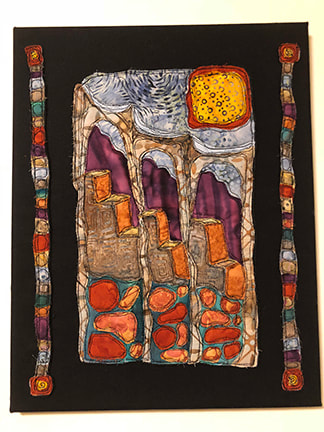


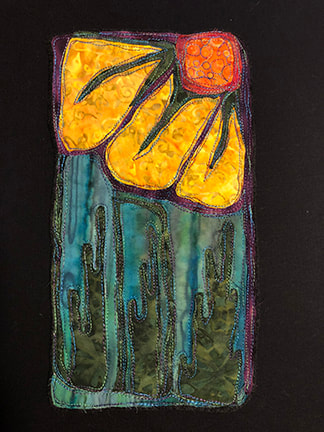








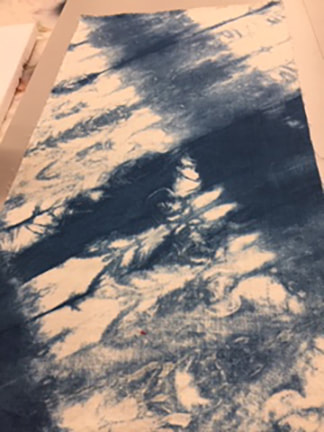


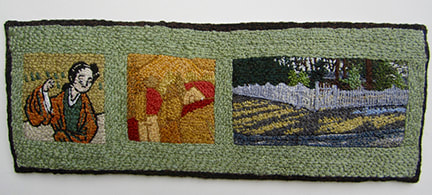








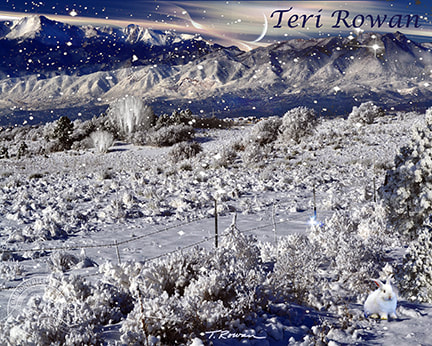








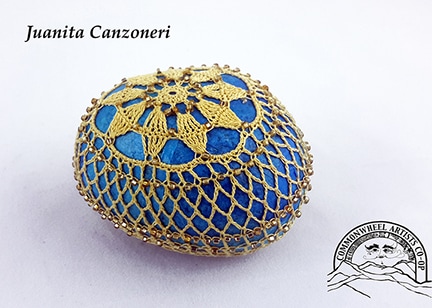
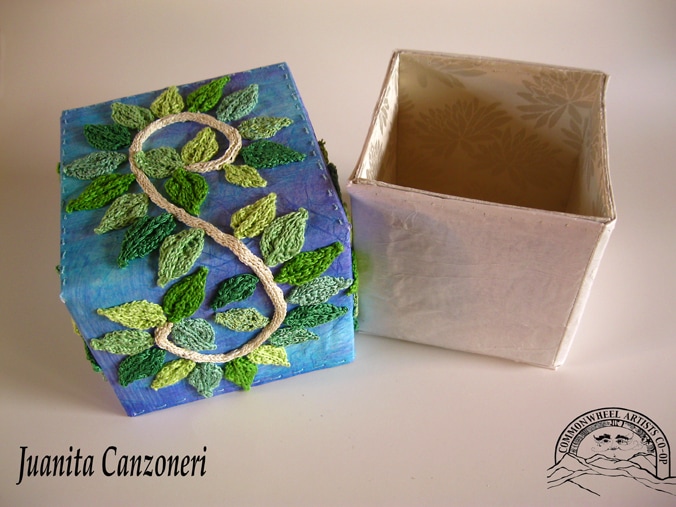





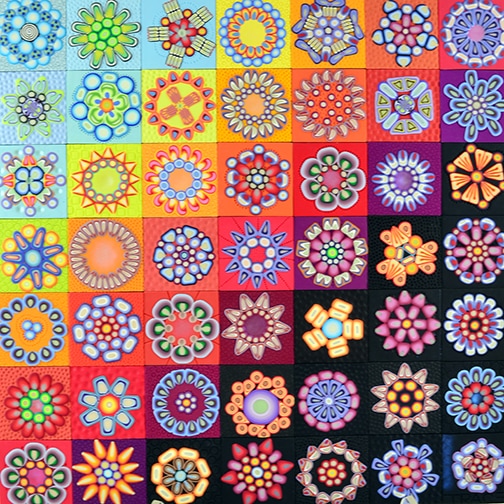



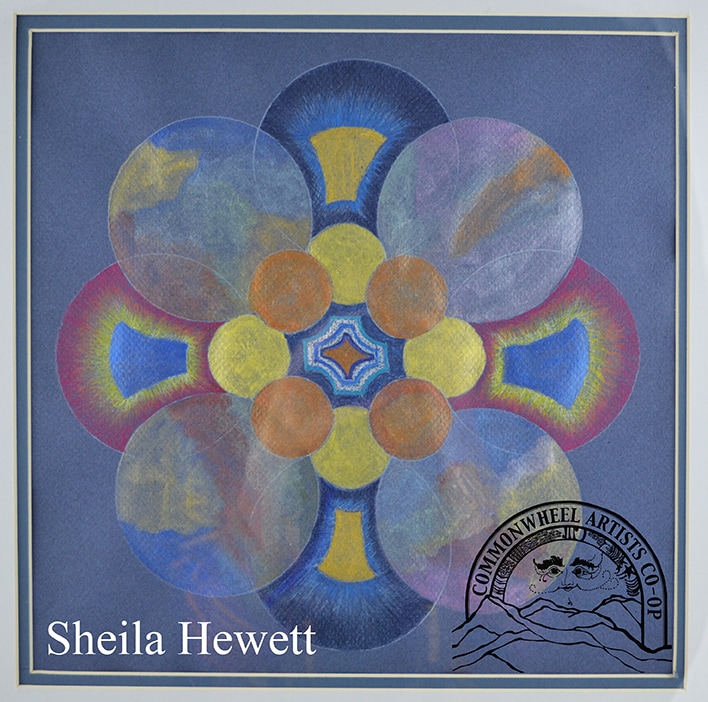





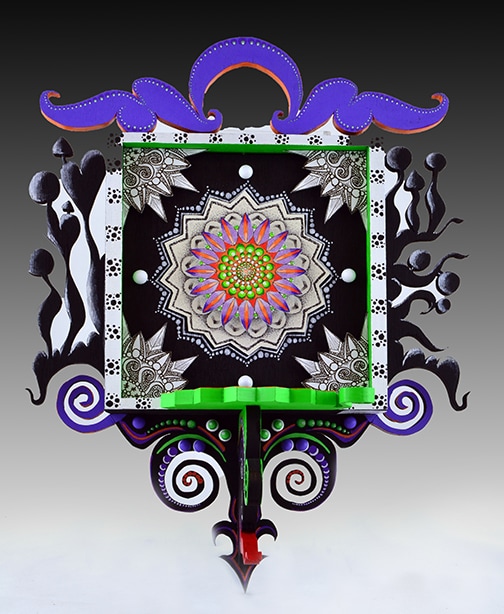



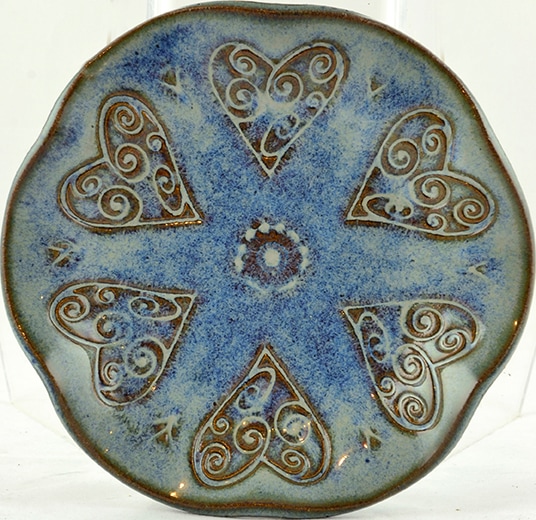



 RSS Feed
RSS Feed